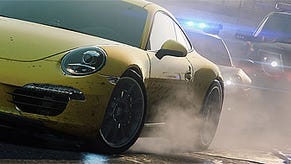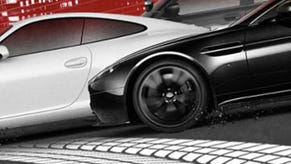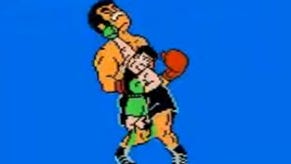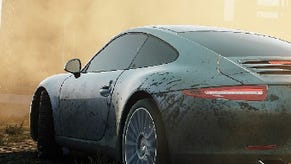Need For Speed: Most Wanted – dealing with grief
As EA and Criterion gear-up to launch Need For Speed: Most Wanted, executive producer Matt Webster and creative producer Hamish Young dispense with the niceties and extol the virtues of good old fashioned griefing.
“Griefing is a whole other part of gaming that people really should get into; we think it’s funny,” offers Criterion’s Matt Webster, executive producer on Need For Speed: Most Wanted.
“It’s funny when it’s personal,” clarifies Hamish Young, Criterion’s creative producer. “When he’s trying to screw me over it’s funny; when it’s some anonymous person online it’s annoying.”
Webster and Young aren’t trying to start a flame war; instead they’re highlighting one of the myriad ways in which friends can experience Need For Speed: Most Wanted. They recount their own experiences of grudge-match japery, which points to good old-fashioned living room gaming that sees friends jostle for position on both the race track and the sofa.
However, for many people, same-room gaming with friends has taken a backseat to online gaming. So, while Need For Speed: Most Wanted comes equipped with the expected options for head-to-head racing against a mix of human and AI opponents, Criterion has also made a big effort to increase the options for asynchronous competitive play.
Most Wanted’s Autolog feature supplies a plethora of data and information about the play sessions of friends, such as the car used and number of tries taken to set a particular record. The end result is that when you can’t manage to pin-down a friend for an extended head-to-head play session, the wealth of information available about their high-speed hijinx can enliven even a 20-minute blast of single-player racing.
“When we came up with [Autolog]for Hot Pursuit, it was actually really difficult to implement it as we had to be very selective about its use because it was a really new concept,” remembers Webster. “Hot Pursuit’s Autolog only worked one race at a time and you had to come out of the experience to get that stat-comparison.
“It was OK, but with [Most Wanted] we wanted to do more and so we push it into the game world by broadening the play styles that it tracks: billboards, big jumps, fastest speed through speed cameras, discovering and collecting things, the list goes on. These are all things that people love to do open-world games, so now you’ve got more competition overall and a broader skill-base covered by that competition.”
Criterion’s intention with the always-present Autolog feature is that it spur on friends in competitive multiplayer by pushing them to acquire bragging rights and engage in that light-hearted griefing. However, Autolog could not only encourage friends to spend more time with Most Wanted’s open world, but also fulfil a useful secondary purpose, too.
Criterion recognises that delivering a driving experience that eschews the standard form of progression and makes available every car from the outset (bar those ten “most wanted”) could have its downsides: such as overwhelming players and leaving them unsure of how best to blaze their trail through its game world.
“And that’s why, from our perspective, Autolog is an opportunity to bring people back together after they’ve gone their separate ways,” Young explains. “Everyone can go off and find different cars and have different experiences but with Autolog we’re able to recommend things to people and say ‘well, your friend did this thing, maybe you want to do this too’.”
Webster elaborates, “Apart from completing the first event, which we all do, he might go left, I’ll go straight-on and you could go right and our experience diverges right there. Now, that for me is the power of the open-world game but we fully appreciate that an open-world can be daunting. You need some structure, we totally get that, and Autolog is the perfect vehicle for that because it offers a focal point for people to challenge their friends.”
The way that Webster and Young describe it, it’s an elegant solution to the potential problem of a lack of player focus that could be caused by the double-edged nature of a world more open than most. Meanwhile, Most Wanted’s headline boast that “if you can find it, you can drive it,” means that while each car still needs to be tracked down in the game world, the fact that they’re unlocked from the start shifts the focus from having to work from the bottom up to being able to enjoy the actual driving experience.
In addition to describing the ten, top tier vehicles controlled by the AI opponents, the most wanted moniker also has two other points of reference, as Webster explains.
“The Most Wanted concept is a very powerful premise, but for us it’s ‘most wanted’ amongst your friends. The cops are a secondary character around the city and are another element of play; they offer a powerful visual theme.”
Most Wanted’s rebellious nature is written into its expansive open-world, which looks set to do away with the tired notion of having to pay your dues before being allowed to experience the thrill of a thrumming, super-charged engine. The ‘loud and proud’ attitude is also evidenced by its prominent Autolog-powered leader boards, which are intended to provide multiple, personalised goals, encourage healthy competition between friends and let you thumb your nose at the authorities.
“It’s very much in our nature to be a bit rebellious, so we have the cops to put that into context in addition to being able to take something beautiful and smash it up,” says Webster.
“I think it just goes to show that there’s a bit of punk attitude in all of us,” concludes Young.
Need For Speed: Most Wanted is out on PC, 360, PS3, Vita, iOS and Android starting October 30 in the US.










